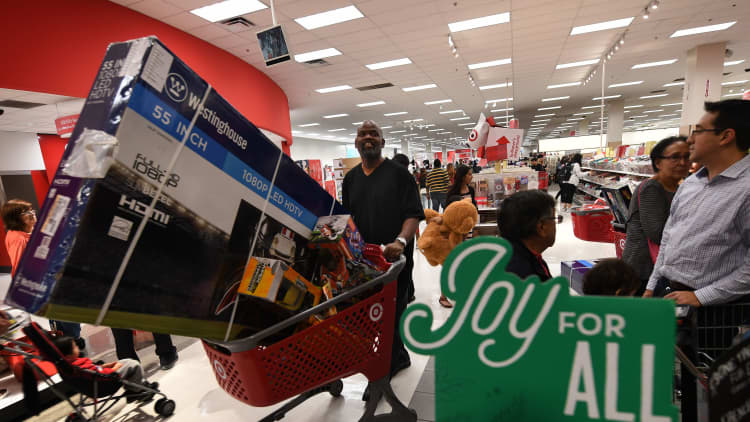Target delivered a bit of a shock to Wall Street on Wednesday morning.
The retailer has over the past year been considered a darling of its industry — posting impressive sales gains both in stores and online, and taking market share from rivals in key categories like apparel and food. It has shined as department store chains such as Macy's and other mall-based companies such as L Brands have struggled. Its shares, as of Tuesday's market close, had skyrocketed more than 80% from a year ago.
But Target's 2019 holiday sales missed the mark, with CEO Brian Cornell saying, "While we knew this season was going be challenging, it was even more challenging than we expected."
The company cited weakness in the electronics, toy and home categories, in particular. Its digital sales also underwhelmed, climbing only 19% compared with growth of 31% during the third quarter, and growth of 29% during the 2018 holiday season.
Despite Target shares tumbling 7% Wednesday, some analysts don't expect the sales miss to be the start of a long-term problem at the discount retailer. The main reason: Target showed strength in some of the areas that matter the most.
"The good news is that some of the shortfall can be explained away," Gordon Haskett analyst Chuck Grom said. "In other words, we don't think the print is a result of anything systemic or structural."
Cornell said Wednesday that he has confidence in the year ahead because the retailer has "built a financial model that — despite the softer sales — still delivered on the bottom line because of a strong gross margin mix, the unique role our stores played in digital fulfillment and our incredibly clean inventory position closing out the holidays."
It was significant that Target was able to maintain its earnings outlook for the fourth quarter and full year even in the face of weaker-than-expected sales. It is scheduled to report its results in March.
Target's turnaround strategy dates to 2017. Since then it has been opening smaller-format stores in urban markets, remodeling larger locations, adding faster delivery options like curbside pickup, and rolling out more private-label products. These strategies are continuing to work, analysts said.
"I don't think anybody is ready to jump out the window in Minneapolis," where Target is headquartered, Moody's senior retail analyst Charlie O'Shea said.
"Having issues in consumer electronics for Target is not as meaningful as people may think. ... When you start looking at where Target has strength, that is where they need to be strong. Apparel and food are the traffic drivers."
Notably, Target saw continued strength in apparel, beauty, and food and beverage during the holidays. And those are the three areas where it has been investing more.

Here's a breakdown of what happened to Target in key categories this holiday season, and some say it might not be as bad as people think.
Toys
Target said its toy sales were about flat compared with a year ago.
But analysts say the company was lapping an incredibly strong 2018 holiday season, following the liquidation of Toys R Us, making the base in the toy category that Target must grow from even larger.
It was ahead of the 2018 holidays when Target devoted more space in stores to toys permanently, and expanded its toy assortment. During the 2018 holiday season, Target's total same-store sales were up 5.7%, due in large part to strength in toys.
Target this year has invested even further in the space. It teamed up with Disney to open mini Disney shops in certain Target locations. And it now powers the website of the relaunched Toys R Us brand post-bankruptcy, which was expected to be a sales driver online around the holidays.
"We had Toys R Us close two years ago. ... Last year was like a toys party," Stacey Widlitz, president of consulting group SW Retail Advisors, said. "I am not worried about Target at all."
Target said Wednesday that, despite its toy sales remaining about flat, it still grew market share in toys during the 2019 holidays, based on NPD Group data. Analysts also point to an overall "lack of newness" in toys this past holiday season that likely weighed on many companies, not only Target.
Electronics
Target said its electronics sales were down more than 6%.
Analysts said Target was not as promotional as other chains in the category, hoping to keep its profitability in check.
In the retail industry, sales of electronics and appliances grew 4.6% from Nov. 1 through Dec. 24, according to an analysis of purchases by Mastercard SpendingPulse.
So while there were gains, they weren't at Target. Winners likely included Best Buy, Costco, Walmart and Amazon, according to O'Shea. Neither Best Buy nor Walmart have reported holiday sales. Amazon has said it had a "record" holiday. And Costco said its sales for the five weeks ended Jan. 5 surged 10.5%, to $17.04 billion.
For Target, O'Shea called electronics a "secondary category."
"They like to have it. ... But beyond that, Target does not need to be the top two of three electronics retailer to be hugely successful," he said.
Home
Target said its home sales dropped about 1% during November and December. It said there was weakness across "portions" of the segment, not its entirety.
Overall for retailers this holiday season, the home furniture and furnishings category grew 1.3%, Mastercard SpendingPulse said.
Gains in home likely went to more "promotional" retailers, like Pier 1 Imports, Widlitz said. Wayfair is another rival online. And Wayfair is known for slashing prices and doling out deals — as maintaining healthy gross margins is not a core focus.
"It's fixable," Sucharita Kodali, a research retail analyst at Forrester, said about Target's holiday results. "At least sales were up and they're managing profit."
Others are saying a shortened holiday calendar this past year — with six fewer days in between Thanksgiving and Christmas compared with the year prior — will end up hurting retailers.
"Holiday 2019 was all about cadence, with early promotions moving a fair amount of holiday sales ahead of the traditional shopping period and a surge of sales during the final week's last minute rush," Marshal Cohen, chief industry advisor at NPD Group, said. "Additionally, consumers continue to migrate to more 'intangible' gifting, putting more emphasis on experiences than things and focusing more on how they live than how they look this holiday."
Target has a market value of about $59 billion. Its shares were last down about 7%, having risen nearly 70% over the past 12 months.




